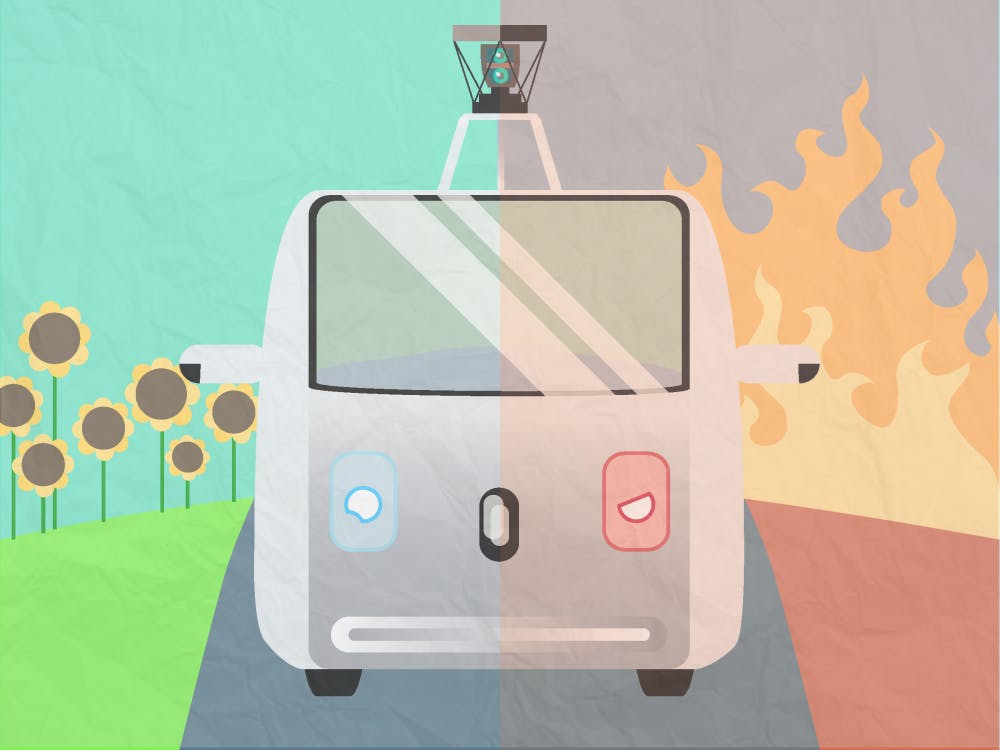In our lifetime and the lifetimes of those before us, self-driving vehicles have seemed like a science-fiction impossibility. However, Google has taken the lead on introducing the modern world to autonomous automobiles.
Caution lights are already flashing due to some bumps in the road ever since models were permitted to test drive on actual streets. The Editorial Board is left with a few concerns — and not just whether ?or not the cars run on search engines. ?With four out of the 48 cars experiencing accidents, the Editorial Boards is feeling lucky to have our own share of automobile aficionados and self-steering cynics to take turns at the wheel of this debate.
Pro Auto Auto
For several years, Google’s research and development department has been pouring its resources into making the self-driving car a reality.
An independent investigation conducted by the Associated Press has revealed that four of the 48 self-driving vehicles Google and other developers currently have in operation have been involved in some sort of accident. While this sounds alarming, an overwhelming amount of evidence is present to calm our fears concerning this project.
First is the actual driving arrangements for the public road tests. These cars are not running around without a human behind the helm. A pilot is behind the wheel at all times. Even when the self-driving system is engaged, the human driver ?remains vigilant.
Additionally, self-driving is made possible by a suite of responsive and predictive technologies. By utilizing cameras, radar sensors, roof-mounted lasers and detailed, manually-compiled maps of the road, the car can read and respond to the road around it with incredible accuracy and immediacy.
Theoretically, these response times can out-perform those of the average driver. While multiple automotive manufacturers are entering the autonomous-car development fray, Google’s efforts are perhaps the most impacting ?and publicized.
A team of 15 of the world’s premier robotics engineers is steering Google’s program, with a cargo of impressive credentials and years of serious experience in autonomous robotics research and development.
Sebastian Thrun, the project’s current leader, was the former director of the Stanford Artificial Intelligence Laboratory and the co-inventor of Google Street View. The AP investigation has turned-up claims from Google and Delphi Automotive, the two companies that owned the four self-driving vehicles involved in the accidents. Both stated that their vehicles were not at fault in any of the accidents, all of which have been described as minor.
Each incident reportedly occurred at speeds under 10 miles per hour; two of the accidents occurred under human control, while the other two occurred while the vehicles were driving. All signs still point to autonomous vehicles becoming the safe and preferred method of commuting in the future. Incapable of being distracted, slow to respond or drowsy at the wheel, self-driving systems will help make both urban commuting and long-distance driving safer.
Lastly, those of us with a passion for driving need not fret. When the driver would like to resume control and enjoy driving the vehicle, full human control will be simple to resume.
Con Auto Auto
Think of a futuristic, Google-dominated world where everything is done for us pathetic, self-serving, lazy human beings. This would include the car industry, where automobiles would live up to their etymology and become self-moving.
Google Inc. envisions a world where these self-driving cars become a shared resource, especially in densely populated, urban areas, therefore eradicating the owner-operator model for the standard automobile.
Instead, you will simply grab your Google-operated smartphone and press a button here and there, and voila! A self-driving car will whiz your way. You get in and are driven off to your desired location. While the intent is to create a higher utilization rate for cars, this self-driving vehicle would also create just as many dangers as it would any potential conveniences for consumers.
First, the self-operating car, if completely successful, would mean everything is centralized — including all of the power. Maintenance, repair, insurance and fueling would all go down in the same place. And that centralization would, of course, be in the hands of Google Inc.
Also, small businesses would evaporate. That locally owned car wash down the road would cease to exist, along with every single of its employees. The same goes for car dealers, independent repair shops and gas stations.
Three of the collisions involving Google’s self-driving cars were documented since September when reporting all accidents became a legal requirement, according to the AP. The requirement is part of the permits for the tests on public roads. While director of Google’s self-driving car development Chris Urmson wrote in a web post that all 11 of the accidents were only minor, and not once was the self-driving car “the cause of the accident,” it was impossible to verify these claims.
The California Department of Motor Vehicles also said it could not release details from accident reports, a clear indication of a troubling lack of transparency. One cannot help but wonder what other dangers could transpire in a collision of an even larger scale involving the self-driving cars, especially in a densely ?populated area.
Google’s long-term goal is for their future model to not have a steering wheel or pedal, thus preventing an actual, breathing human from taking over if the car loses control. This means consumers are literally putting their trust and their safety into Google’s hands if something were to go wrong.
While the idea of a self-driving car sure is nifty, Google needs to make sure it works out every single little kink before unleashing it into mass production. And there are still those lost local jobs ?to justify.




